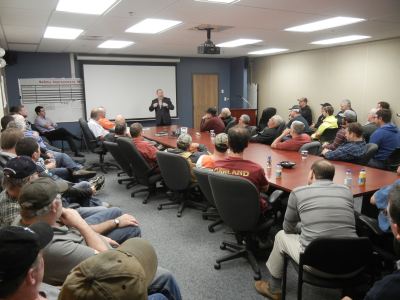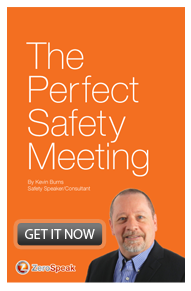The best safety meetings have both conviction and experience. The safety meeting is far too important to hand off to an inexperienced person and hope that it goes OK.
 Can employees lead the safety meeting? It is an idea that hopes to lead to increased engagement. The thinking is that if a new voice speaks, people will listen. If a staffer leads the meeting, then others will engage better. It might be true. But there is a stronger case for not putting the responsibility onto employees.
Can employees lead the safety meeting? It is an idea that hopes to lead to increased engagement. The thinking is that if a new voice speaks, people will listen. If a staffer leads the meeting, then others will engage better. It might be true. But there is a stronger case for not putting the responsibility onto employees.
Good safety meetings are an art-form that need practice, strategy and planning. Leading them effectively takes patience and tenacity. Swapping out meeting leaders creates a throw-away safety meetings culture.
It's true that every person has an equal responsibility for safety. Every employee must contribute to making the safety program work. But the safety meeting is a legal requirement. People skilled in running effective safety meetings must be in charge. Employees are welcome to present segments at the meeting. But, the safety meeting content strategy must be up to one person - the safety meetings leader.
Boring safety meetings are caused by two things: boring content and boring presenters. That's it. If the content becomes more engaging and if the presenter becomes more engaging, people will engage. But, you don't need to turn the meetings over to the people you're trying to engage for that to happen. You just need to get better at safety meetings.
Here are 5 reasons why the responsibility for safety meetings should always rest with the safety manager:
1Consistency Breeds Familiarity. You wouldn’t ask an employee to operate a piece of machinery without proper training. Don’t just throw anyone into a leadership role without preparing and training them first. Does the employee know the intricacies of the safety program as well as a safety manager? Could they handle all questions from the floor? One errant comment or suggestion not caught at the moment can create mixed messages and confusion. There should never be confusion of the procedures in safety.
2Keep It Positive. Safety has a reputation of aligning itself with scare tactics and gruesome videos. Injury is not safety. Keep tight control on the content of a safety meeting. Inexperienced presenters using severed-limb photos and generic Internet videos are infringements of Copyright. They also have nothing to do with safety. The purpose of any safety meeting is to make the organization better - not just better-informed. Keep it positive. Focus on safety - not on injury. That takes practice.
3Protect Your Employees. In the same way you would protect your employees from physical harm, you must protect them from mental harm. Pick your presenters or meeting leaders with extreme care. Take control of who and what gets exposure to the minds of your employees. Protect your people from a lack of preparation and conflicting information. Presentations must move the organization forward.
4Engage Their Minds. The strategy for good safety meetings should be to avoid boring your people. Period. But that's tough when the subject-matter is boring. Even worse, when the presenters, are boring, ill-prepared and stumbling through a first-time meeting. It is difficult for employees to engage in a meeting full of statistics, graphs and performance charts. Engaging employees takes practice and experience.
5This Is An Investors Meeting. Think about your safety meeting as an investors’ meeting. You are asking your people to invest in the safety program and to buy-in to the corporate vision for safety. You only get one major opportunity to appeal to your “investors” for their buy-in to your vision. That’s the safety meeting. If they reject your proposal, you will have to wait the next meeting for the same opportunity. Will you leave that up to one inexperienced person to fulfill?
The best safety meetings have both conviction and experience. The safety meeting is far too important to hand off to an inexperienced person and hope that it goes OK. There is no place for hope in a safety meeting. Safety is something you drill into the hearts and minds of your employees. You prepare them to act should they need to. Let them do what they already do well - work safely.
The responsibility for running a well-managed safety meeting is crucial. That responsibility must rest with the safety manager (adviser, supervisor, foreman, etc).
In my work with clients, I spend countless hours preparing to present for one hour. I must ensure that my safety presentation aligns with and supports what they have been saying to their people. I also assess what they would like to have happen as a result of my presentation. Then I put my energies into accomplishing that. Safety is far too important to put just any person in charge of the safety meeting.
In my book, The Perfect Safety Meeting, I discuss several strategies to improve safety meetings. It's a free download.



